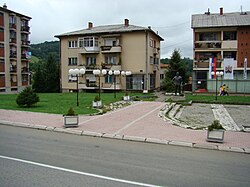Rudnik
Рудник | |
|---|---|
Village | |
 | |
| Coordinates: 44°08′27″N 20°29′56″E / 44.14083°N 20.49889°E | |
| Country | |
| District | Moravica District |
| Municipality | Gornji Milanovac |
| Area | |
• Total | 23.38 km2 (9.03 sq mi) |
| Elevation | 595 m (1,952 ft) |
| Population (2011) | |
• Total | 1,490 |
| • Density | 64/km2 (170/sq mi) |
| Time zone | UTC+1 (CET) |
| • Summer (DST) | UTC+2 (CEST) |
Rudnik is a village in the municipality of Gornji Milanovac, Serbia. According to the 2011 census, the town has a population of 1,490 people.[1]
History
[edit]In 1363 it was under the control of Nikola Altmanović. It probably fell under the control of his uncle Vojislav Vojinović some years earlier and had been granted to Nikola as a vassal.[2]
Mineral resources in this area attracted the attention of the Old Romans, who conquered this region later since they needed the ore to forge coins and arms. After a long period of battles with the Celts and the remaining Illyrians, the area was integrated into the Roman provinces. Right next to the mine shafts on the south-western side of Mt. Rudnik, a stone plate was found with the inscription: TERRA MATER TEA – “The Mother Earth Goddess”. This temple served to the miners who prayed there for rescue in case of emergency before entering the shaft. The temple was destroyed at one point in time, to be reconstructed by the Emperor Septimius Severus, who placed the above- mentioned stone plate at its entrance. One millennium later first documents mentioning Rudnik can be found. Since 1300 silver coins in medieval Serbia are made at Rudnik under the rule od king Dragutin. It was a prosperous time for Rudnik. This importance of Rudnik last for more than 150 years, until 1458. Coins had 2.4 grs and they were more valuable than other coins made in Serbia. Apart from Silver, Lead and Copper were also extracted. [3] [4]
References
[edit]- ^ Popis stanovništva, domaćinstava i Stanova 2002. Knjiga 1: Nacionalna ili etnička pripadnost po naseljima. Republika Srbija, Republički zavod za statistiku Beograd 2003. ISBN 86-84433-00-9
- ^ R. Mihaljčić, Kraj Srpskog Carstva, SKZ, Beograd. 1975. pp. 36.
- ^ RUDNIK I VENČAC Sa okolinom u srednjem veku i ranoj moderni Tematski zbornik radova sa naučnog skupa održanog 21. oktobra 2017. godine u Narodnom muzeju u Aranđelovcu Urednici: Siniša Mišić, Dejan Radičević, Marko Šuica (Narodni muzej Aranđelovac – Aranđelovac / Centar za istorijsku geografiju i istorijsku demografiju, Filozofski fakultet – Beograd, Aranđelovac, 2018, broš, 326)
- ^ "Home - Rudnik". Retrieved 2024-06-21.
44°08′27″N 20°29′56″E / 44.14083°N 20.49889°E

